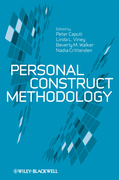
Written by an international team of experts, this collection provides a comprehensive account of established and emerging methods of collecting and analysing data within the framework of personal construct theory. Covers methods suchas content analysis scales, repertory grid methodology, narrative assessmentsand drawings, the laddering and ABC techniques, and discusses how and why they are used Explores both qualitative and quantitative methods, as well as methods used in clinical and counselling settings Includes 13 contributions from leading international scholars ÍNDICE: SECTION I: SETTING THE SCENE. 1 Assessment of personal constructs:Features and functions of constructivist techniques (Heather Gaines Hardison,Clinical Psychologist, Tennessee, USA & Robert A. Neimeyer, University of Memphis, USA). 2 Qualitative methods in Personal Construct Psychology: A set of possible criteria. (Linda L. Viney, University of Wollongong, Australia & Sue Nagy, University of Technology, Australia). SECTION II: QUALITATIVE APPROACHES - EXPLORING PROCESS. 3 The use of laddering techniques: Techniques, applications and problems (Beverly M. Walker, University of Wollongong, Australia & Nadia Crittenden, University of Wollongong, Australia). 4 The ABC model revisited(Finn Tschudi, University of Oslo, Norway, & David Winter, University of Hertfordshire, UK). 5 The self-characterisation technique: Uses, analysis and elaboration(Nadia Crittenden, University of Wollongong, Australia)& Chantel Ashkar, University of Wollongong, Australia). 6 Experience cycle methodology: A method for understanding the construct revision pathway (Lindsay G. Oades, University of Wollongong, Australia) & Linda L. Viney, University of Wollongong, Australia). SECTION III: QUANTITATIVE APPROACHES - EXPLORING PROCESS. 7 An introduction to grid based methods (Peter Caputi, University of Wollongong, Australia). 8 Analysing grids: New and traditional approaches(Peter Caputi, University of Wollongong, Australia, Richard Bell, University of Melbourne, Australia & Desley Hennessy, University of Wollongong, Australia). 9 Computer-aided constructivism (Brian R. Gaines, University of Calgary, Canada & Mildred L. G. Shaw, University of Calgary, Canada). 10 Using constructivist-oriented content analysis scales (Linda L Viney, University of Wollongong, Australia &Peter Caputi, University of Wollongong, Australia). SECTION IV: METHODS IN COUNSELLING AND CLINICAL SETTINGS. 11 Narrative assessment in psychotherapy: A constructivist approach (Luis Botella (Ramon Llull University, Spain & María Gámiz, Ramon Llull University, Spain). 12 Using contrasting drawings or pictures as an assessment tool within a personal construct framework (Heather Foster, University of Wollongong, Australia & Linda L Viney University of Wollongong, Australia). 13 Personal Construct Psychotherapy techniques with adolescents: An integrated model (Miriam Stein, Clinical Psychologist, Surry Hills, Australia , Elaine Atkinson, Clinical Psychologist, Subiaco, Australia & Anne Fraser, Clinical Psychologist, Kensington, Australia).
- ISBN: 978-0-470-77087-0
- Editorial: John Wiley & Sons
- Encuadernacion: Cartoné
- Páginas: 352
- Fecha Publicación: 04/11/2011
- Nº Volúmenes: 1
- Idioma: Inglés
